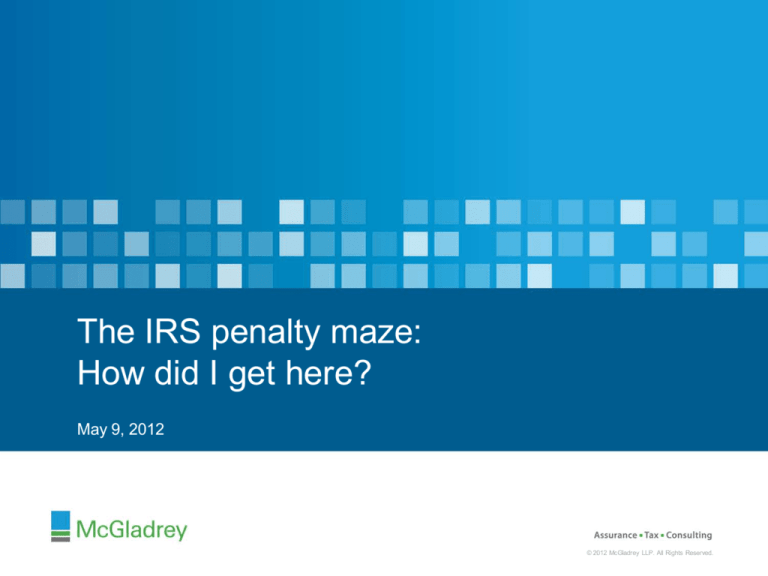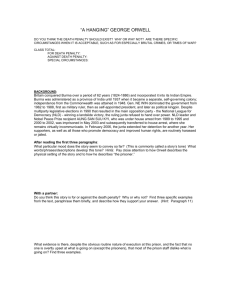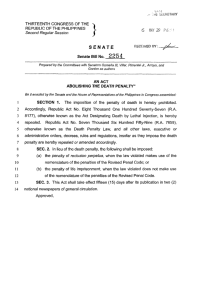
The IRS penalty maze:
How did I get here?
May 9, 2012
© 2012 McGladrey LLP. All Rights Reserved.
© 2012 McGladrey LLP. All Rights Reserved.
Today’s presenters
Patti Burquest
David Click
Principal
Tax Controversy Services
Washington National Tax
patti.burquest@mcgladrey.com
Director
Tax Controversy Services
Denver Office
david.click@mcgladrey.com
© 2012 McGladrey LLP. All Rights Reserved.
Agenda
Delinquency penalties
-
Failure to file
Failure to pay
Failure to make timely estimated tax payments
Failure to deposit
Accuracy-related penalties
-
Negligence, disregard
Substantial understatement
Non-economic substance
Valuation
Claim-related penalties
2
© 2012 McGladrey LLP. All Rights Reserved.
Delinquency penalties
There are four basic delinquency penalties:
-
-
Failure to file (or late filing)
•
•
•
•
Income tax returns
Excise tax returns
Payroll tax returns
Information returns
Failure to pay tax
•
•
With return
Shown on an IRS notice
Failure to pay estimated tax
•
Income tax
Failure to deposit
•
•
•
Income taxes
Payroll taxes
Withholding taxes
3
© 2012 McGladrey LLP. All Rights Reserved.
Failure to file (or late filing) of income, excise
and employment tax returns
Penalties are described in section 6651(a)(1)
Penalty rate is five percent per month (or fraction thereof)
based on the amount of tax required to be shown on the
return
Imposed on the net amount of tax due with return
-
Tax required to be shown on the return is reduced by tax
payments made on or before the return due date (without
extensions) and credits claimed on the return
Penalty begins to accrue from the return due date (including
extensions of time to file)
4
© 2012 McGladrey LLP. All Rights Reserved.
Failure to file (or late filing) of income, excise
and employment tax returns (cont.)
Continues to accrue until the return is filed (or the maximum
penalty is reached)
Maximum penalty is 25 percent
If the failure to pay penalty (section 6651(a)(2)) also applies,
the failure to file penalty rate is reduced to 4.5 percent per
month. The maximum combined failure to file and failure to
pay penalty associated with a delinquent return is five percent
per month.
Can be avoided by filing a timely return (even if the tax is not
paid with the return)
Reasonable cause is a defense
5
© 2012 McGladrey LLP. All Rights Reserved.
Penalties for failure to file information returns
Partnership returns (Form 1065) and S corporation returns
(Form 1120S)
-
$195/month per partner or shareholder up to 12 months
Exempt organization returns (Form 990)
-
Gross receipts ≤ $1,000,000 - $20/day, maximum of $10,000
Gross receipts > $1,000,000 - $100/day, maximum of $50,000
Failure to file with IRS (1099s, W-2s and 1042s) – required to
be filed in 2012 and future
-
$30 per failure (max of $250,000) if filed within 30 days of due
date
$60 per failure (max of $500,000) if filed after 31 days and
before Aug. 1
$100 per failure (max of $1,500,000) for returns filed after Aug. 1
$250 per failure for intentional disregard
6
© 2012 McGladrey LLP. All Rights Reserved.
Penalties for failure to file information returns
(cont.)
Failure to provide timely and correct information statement to
payee/partner/shareholder – in 2012 and future
-
$100 per failure
$250 or more per failure if willful
7
© 2012 McGladrey LLP. All Rights Reserved.
Failure to pay penalties
Penalty applies in two circumstances
-
Failure to pay the tax shown on any return (section 6651(a)(2))
•
•
Income tax returns
Excise tax returns
Failure to pay tax pursuant to IRS notice and demand for
payment (section 6651(a)(3))
•
•
Within 21 calendar days of IRS notice and demand, or
Within 10 business days of the IRS notice and demand for a tax if
the amount on the notice is $100,000 or more
Penalty rate is 0.5 percent per month
-
The section 6651(a)(2) penalty runs from the return due date
(without extension) until the date the tax is paid
The section 6651(a)(3) penalty runs from the 11th or 22nd day
from the notice (whichever applies) until the balance is paid
Penalty rate increases to one percent per month if receive a levy
notice
8
© 2012 McGladrey LLP. All Rights Reserved.
Computation of the failure to file and failure to
pay penalties for late returns
For late filing and payment associated with a return filing, the
failure to pay penalty is credited against the failure to file
penalty so that a combined total penalty of five percent per
month accrues for the first five months of delinquency
Thereafter, the failure to pay penalty continues to accrue at
0.5 percent per month, up to a maximum penalty accrual of 25
percent
Example:
Failure to file penalty (5 months)
Failure to pay penalty (60 months)
Total maximum penalty
=
=
=
22.5 %
25.0 %
47.5 %
9
© 2012 McGladrey LLP. All Rights Reserved.
Computation of the failure to file and failure to
pay penalties for late returns (cont.)
Pointers to minimize delinquency penalties:
-
Request automatic extension of return due date
Make a proper estimate of the liability
For corporations, pay the estimated liability
File the return on time, even if the liability is not paid with the
return
Tax paid after the original return due date does not reduce the
failure to pay penalty but not the failure to file penalty
Seek abatement of penalties under appropriate circumstances
10
© 2012 McGladrey LLP. All Rights Reserved.
Failure to make timely estimated payments
A penalty is imposed for failure to make timely payments of
estimated tax
This penalty applies to individuals (section 6654) and
corporations (section 6655)
Individuals who fail to have sufficient withholding from their
income or fail to make adequate estimated tax payments are
subject to the penalties
The penalty is computed by applying the underpayment rate
under section 6621 to the amount of the underpayment for the
period of the underpayment
11
© 2012 McGladrey LLP. All Rights Reserved.
Failure to make timely estimated payments
(cont.)
The period of any underpayment runs from the due date of the
installment to the earlier of:
-
The due date (without extension) of the income tax return, or
The date on which the portion is paid
Failure by individual – section 6654
-
Penalty exceptions – The penalty applies to individuals who
have not evenly paid tax estimates and/or who have insufficient
withholding amounts equal to the lesser of:
•
•
90 percent of the tax shown on the current year’s return (including
SE tax if self-employed), or
100 percent of the tax shown on the return for the preceding year
(110 percent if taxpayer(s) has adjusted gross income for the prior
year exceeding $150,000)
12
© 2012 McGladrey LLP. All Rights Reserved.
Failure to make timely estimated payments
(cont.)
-
Penalty exceptions (cont.)
•
•
•
-
A taxpayer who has uneven income throughout the year may use
an annualized income installment method that may result in a
smaller installment being required for one payment with a
subsequent increase in a latter payment
Individuals who owe less than $1,000 with their return are not
subject to the penalty
Individuals who filed a return for the preceding taxable year (and
that return was for a period of 12 months) reflecting no tax liability
are not subject to the penalty
Calculations for the penalty and the use of the annualization
method are made by completing IRS Form 2210 and attaching it
to 1040. Or, the taxpayer may allow the IRS to assess the
penalty by not filing Form 2210. In the latter case, interest and
late payment penalty do not begin to accrue until 21 days after
the IRS has notified the taxpayer that it owes the penalty.
13
© 2012 McGladrey LLP. All Rights Reserved.
Failure to make timely estimated payments
(cont.)
Failure by corporation to pay estimated tax – section 6655
-
Under current law, the required quarterly installment payment is
either:
•
•
-
25 percent of the tax shown on the current year return, or in the
case of corporations with less than $1,000,000 of taxable income in
any of the three preceding tax years, the required payment is the
lesser of 25 percent of the tax on the current year return or 25
percent of the tax for the preceding tax year
An amount calculated using an annualized income or adjusted
seasonal installment amount (Form 2220)
Penalty exception
•
•
•
No penalty is assessed if the tax for the year is less than $500
Calculations of the penalty and the use of the annualization method
are made by completing Form 2220 and attaching it to the 1120.
The taxpayer may allow the IRS to assess the penalty by not filing
Form 2220.
In the latter case, interest and late payment penalty do not begin to
accrue until 21 days after the IRS has notified the taxpayer that it
owes the penalty
14
© 2012 McGladrey LLP. All Rights Reserved.
Failure to deposit penalty
Applies to failure to deposit taxes by any person who is
required to deposit taxes (e.g., corporate income taxes, excise
taxes, withholding taxes, employment taxes) (section 6656)
Penalties are imposed against an underpayment on a sliding
scale
-
2 percent if the deposit is not more than five days late
5 percent if the deposit is more than five days late, but not more
than 15 days late
10 percent if the deposit is more than 15 days late
The IRS will apply deposits to the earliest liability, often
creating a cascading penalty
15
© 2012 McGladrey LLP. All Rights Reserved.
Failure to deposit penalty (cont.)
Taxpayers can reallocate the deposits to specific liability dates
and minimize the penalties (section 6656(e))
Penalty exception for first-time depositors of employment
taxes (section 6656(c)) – failure must be inadvertent and must
meet certain criteria
Pointers:
-
Apply late deposits to minimize penalties by providing
instructions with the deposit
Use EFTPS system, if required, to avoid 10 percent penalty for
not using EFTPS, even for timely payments
Seek abatement for reasonable cause or for administrative
waiver
16
© 2012 McGladrey LLP. All Rights Reserved.
Accuracy-related penalty – section 6662
Accuracy-related penalty – section 6662
Imposed on underpayments of tax for:
•
•
•
•
•
•
Negligence
Intentional disregard of rules or regulations
Substantial understatement of income tax
Substantial valuation misstatement under Chapter 1
Substantial overstatement of pension liabilities
Substantial estate or gift tax valuation understatement
Penalty amount – 20 percent of underpayment (40 percent in
the case of certain “gross” valuation misstatements or
undisclosed transactions to which the ESD would apply)
No stacking of section 6662 accuracy-related penalties
Reasonable cause and good faith exception
17
© 2012 McGladrey LLP. All Rights Reserved.
Accuracy related penalty – standards of
authority
Based on probability of a position succeeding on its
merits if challenged by the taxing authority:
Will: > 95 percent
Should: > 70 percent
More likely than not: > 50 percent
Substantial authority: Authority in support of position is
substantial in relation to authority against (approximately 40
percent)
Realistic possibility of success: 33 percent
Reasonable basis: Reasonably based on one or more authorities
(approximately 20 percent)
Not frivolous
Frivolous
18
© 2012 McGladrey LLP. All Rights Reserved.
Negligence penalty
Penalty applies if an underpayment is due to the taxpayer’s
negligence
Negligence includes a failure to make a reasonable attempt to
comply with the tax law or to exercise ordinary and reasonable
care in preparing a tax return
Negligence can include failure to substantiate items on the
return or failure to keep adequate records
Reasonable basis standard applies (i.e., position is
reasonably based on one or more authorities)
No disclosure exception
19
© 2012 McGladrey LLP. All Rights Reserved.
Disregard penalty
Penalty applies if an underpayment results from the reckless
or intentional disregard of a rule or regulation
“Rule” includes Internal Revenue Code, revenue rulings and
notices
“Regulation” includes final or temporary, but not proposed,
regulations
Penalty does not apply if taxpayer discloses position and
position has a reasonable basis
-
Form 8275 (contrary to a rule)
Form 8275-R (contrary to a regulation)
•
-
Position must be a good faith challenge to the validity of the
regulation
Also must disclose on a Form 8886 if position relates to a
reportable transaction
20
© 2012 McGladrey LLP. All Rights Reserved.
Disregard penalty (cont.)
Special rule for undisclosed position contrary to a revenue
ruling or notice:
-
No penalty applies if position has a 1-in-3 possibility of being
sustained on its merits if challenged (provided position does not
relate to a reportable transaction)
21
© 2012 McGladrey LLP. All Rights Reserved.
Substantial understatement penalty
Penalty applies if there is an understatement of income tax
and the understatement is substantial
C corporation – understatement is substantial if it exceeds the
lesser of:
•
•
10 percent of tax required to be shown on the return (or $10,000,
if greater), or
$10 million
All other taxpayers – understatement is substantial if it
exceeds the greater of:
•
•
10 percent of tax required to be shown on the return, or
$5,000
22
© 2012 McGladrey LLP. All Rights Reserved.
Substantial understatement penalty (cont.)
A potential understatement is reduced by the tax attributed to
a position that either:
-
Meets the substantial authority standard; or
Meets the reasonable basis standard and is adequately
disclosed on the return (Form 8275)
No reduction for understatements related to “corporate tax
shelters,” even if disclosed
23
© 2012 McGladrey LLP. All Rights Reserved.
What is “adequate disclosure”?
Form 8275
Form 8275-R
Schedule M-3
Schedule UTP
Rev. Proc. 94-69
Questions:
-
Can a white paper disclosure be “adequate”?
Can disclosure on Form 8886 be “adequate”?
24
© 2012 McGladrey LLP. All Rights Reserved.
Qualified amended returns – substantial
understatement penalty
QAR: The amount shown as tax on a return includes the
additional tax shown on a QAR
Must file before date:
-
Taxpayer is contacted for examination of return
Pass-through entity is contacted concerning an examination of
the return relating to the pass-through item
Any person is contacted for a section 6700 return examination
related to the claimed benefit
John Doe summons is served on third person
IRS contacts tax shelter organizer, promoter, seller or material
adviser about listed transaction
IRS announces settlement initiative for listed transaction
25
© 2012 McGladrey LLP. All Rights Reserved.
Standards of authority for substantial
understatement penalty (non-tax shelter)
Substantial authority
-
The weight of authorities supporting a position must be
substantial in relation to the weight of authorities supporting the
contrary position
Quantified – approximately a 40 percent chance of prevailing on
the merits
Reasonable basis (plus disclosure)
-
Return position that is reasonably based on one or more
authorities
Quantified – approximately a 20 percent chance of prevailing on
the merits
Reasonable Cause
-
Taxpayer must establish that it exercised ordinary business care
and prudence in taking the offending return position
Reasonable reliance on the advice of a tax adviser may support
reasonable cause. See United States v. Boyle, 469 U.S. 241
(1985)
26
© 2012 McGladrey LLP. All Rights Reserved.
Standards of authority for substantial
understatements attributable to a tax shelter
A higher standard of authority must be met to avoid the
substantial understatement penalty for positions related to a
tax shelter.
-
Tax shelter is defined as
•
•
•
•
A partnership or other entity
Any investment plan or arrangement, or
Any other plan or arrangement
If a significant purpose of such partnership, entity, plan or
arrangement is the avoidance or evasion of federal income tax
The position must have substantial authority and the taxpayer
must reasonably believe that the position would more likely
than not be sustained if challenged by the IRS. Negative
factors can destroy the “reasonable belief” required to meet
this standard.
27
© 2012 McGladrey LLP. All Rights Reserved.
Penalty for disallowed tax benefits by reason of a
transaction that lacks economic substance
Section 6662(b)(6) enacted in 2010
Effective for transactions entered into after March 30, 2010
For a transaction that “does not have economic effect or lacks
a business purposes” (section 7701(o))
Penalty equal to 20 percent of the underpayment
Penalty increased to 40 percent if the taxpayer does not
adequately disclose the transaction (section 6662(i))
“Reasonable cause” may not apply
Can avoid penalty by filing a qualified amended return that
concedes the issue
Can avoid the increased penalty by filing a qualified amended
return that discloses the transaction that does not have
economic substance
28
© 2012 McGladrey LLP. All Rights Reserved.
Valuation misstatement penalties
Valuation misstatements come in several flavors
-
Substantial valuation misstatements under Chapter 1 of the
Internal Revenue Code
Substantial overstatements of pension liabilities
Substantial estate or gift tax valuation understatements
Penalty increased to 40 percent for gross valuation
misstatements
Avoid penalty by documentation and reasonable cause
-
Use of qualified appraisal
Good faith investigation of property value
29
© 2012 McGladrey LLP. All Rights Reserved.
Claim-related penalties – section 6676
20 percent penalty for claims in an “excessive amount”
•
•
•
Applies to claims for refund or credit of income tax via an
amended return, Form 843, or an original return
Avoided if claim meets the reasonable basis standard, unless
relates to a transaction without economic substance (as defined
in section 6662)
Cannot be combined with the section 6662 or section 6663
penalty
Applies to claims filed after May 25, 2007
30
© 2012 McGladrey LLP. All Rights Reserved.
Disclaimer
The information contained herein is general in nature and based on
authorities that are subject to change. McGladrey LLP guarantees neither the
accuracy nor completeness of any information and is not responsible for any
errors or omissions, or for results obtained by others as a result of reliance
upon such information. McGladrey LLP assumes no obligation to inform the
reader of any changes in tax laws or other factors that could affect information
contained herein. This publication does not, and is not intended to, provide
legal, tax or accounting advice, and readers should consult their tax advisors
concerning the application of tax laws to their particular situations.
Circular 230 Disclosure
This analysis is not tax advice and is not intended or written to be used, and
cannot be used, for purposes of avoiding tax penalties that may be imposed
on any taxpayer.
McGladrey LLP is the U.S. member of the RSM International (“RSMI”)
network of independent accounting, tax and consulting firms. The member
firms of RSMI collaborate to provide services to global clients, but are
separate and distinct legal entities which cannot obligate each other. Each
member firm is responsible only for its own acts and omissions, and not those
of any other party.
McGladrey, the McGladrey signature, The McGladrey Classic logo, The
power of being understood, Power comes from being understood and
Experience the power of being understood are trademarks of McGladrey LLP.
© 2012 McGladrey LLP. All Rights Reserved.
McGladrey LLP
1501 M Street NW
Suite 340
Washington, D.C.
20005
888.811.1023
www.mcgladrey.com
© 2012 McGladrey LLP. All Rights Reserved.








